Do you find yourself tossing and turning throughout the night, struggling to fall asleep? The culprit behind your sleepless nights may be the blue light emanating from your electronic devices. Blue light, which is emitted by smartphones, tablets, laptops, and LED lights, can disrupt your circadian rhythm, throwing off your sleep-wake cycle and negatively impacting your overall health.
Key Takeaways
- Blue light exposure can disrupt your circadian rhythm, leading to sleep problems and other health issues
- Melatonin production, a hormone crucial for regulating sleep, can be suppressed by blue light
- Managing blue light exposure, especially before bedtime, can improve sleep quality and quantity
- Light exposure during the day is important for maintaining a healthy circadian rhythm
Understanding Circadian Rhythm and Its Importance
If you’ve ever felt groggy in the morning or have trouble staying awake during the day, you may have experienced a disruption in your circadian rhythm. This natural, internal clock regulates our sleep-wake cycle and influences many bodily functions, including hormone production, digestion, and even body temperature.
The circadian rhythm responds primarily to light and dark signals, which help to regulate its natural 24-hour cycle. Blue light, emitted by electronic devices and LED lights, can disrupt the circadian rhythm by suppressing the production of melatonin, a hormone that helps us fall asleep and stay asleep throughout the night.
Blue light and circadian rhythm disruption have become a growing concern in modern society, as many people spend extended periods indoors exposed to artificial lighting and electronic devices. The adverse effects of this exposure can have serious consequences on our health and well-being if left unaddressed.
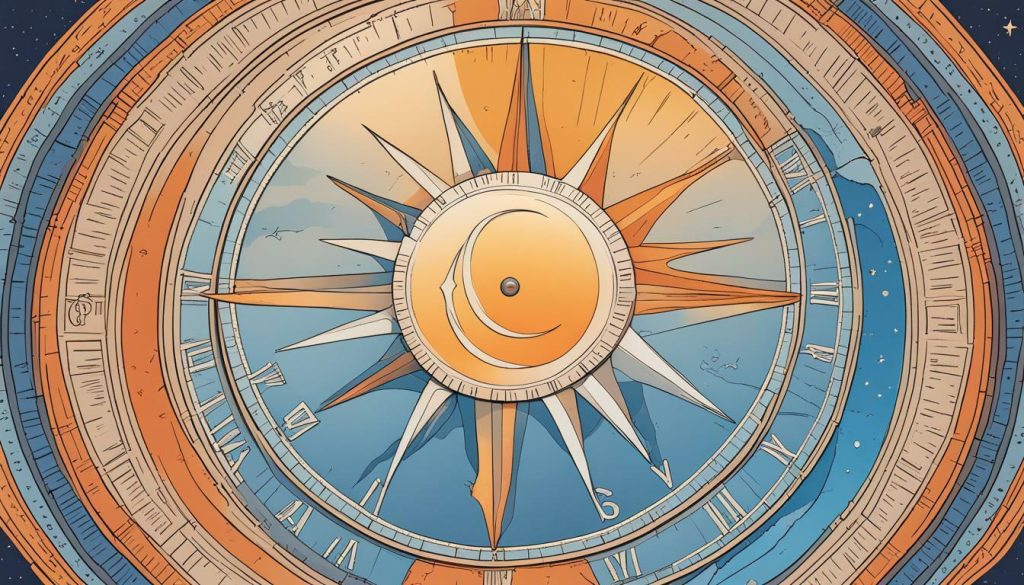
Research has shown that circadian rhythm disruption is linked to a range of health issues, including obesity, diabetes, and cardiovascular disease. Additionally, poor sleep quality, which can be caused by blue light exposure, can lead to mood disorders, cognitive impairment, and even a weakened immune system.
Understanding the importance of the circadian rhythm and the impact of blue light exposure is crucial for maintaining good health and promoting optimal sleep quality. By taking steps to regulate these factors, we can improve our overall well-being and lead happier, healthier lives.
The Role of Blue Light in Circadian Rhythm Disruption
Blue light exposure can have a profound effect on our circadian rhythm, which regulates our sleep-wake cycle. Disruptions to this natural cycle can cause a range of health issues, including insomnia, mood disorders, and decreased cognitive performance.
One of the key ways blue light affects our circadian rhythm is through its impact on melatonin production. Melatonin is a hormone that helps to regulate sleep, and exposure to blue light can suppress its production.
Studies have shown that exposure to blue light in the late evening and night can significantly reduce melatonin levels, leading to sleep disruption and circadian rhythm disruption. This can have a particularly significant impact on those who work night shifts or have irregular sleep schedules.
Research has also linked blue light exposure to an increased risk of depression and other mood disorders. This is thought to be due to the disruption of melatonin production and the circadian rhythm, which can affect the body’s ability to regulate mood and emotional responses.
Overall, managing blue light exposure is essential for maintaining a healthy circadian rhythm and ensuring quality sleep. By reducing exposure to blue light-emitting devices and incorporating strategies such as blue light filters and optimizing bedroom lighting, individuals can help regulate their sleep-wake cycle and improve their overall health.
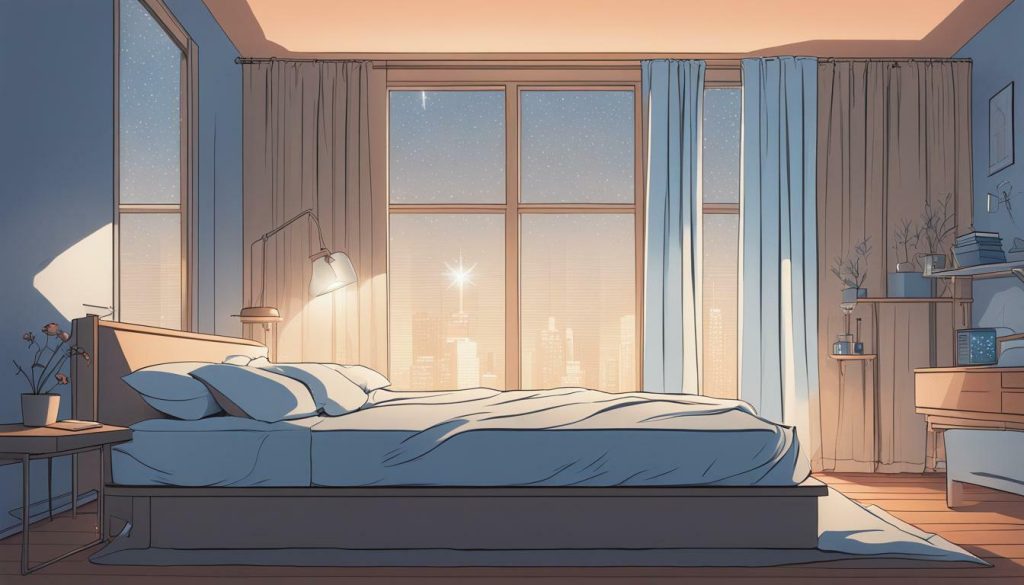
Blue Light Sources and Their Effects on Sleep
Exposure to blue light from electronic devices, LED lights, and natural sunlight can impact sleep quality and duration. Research suggests that blue light exposure before bedtime can disrupt the body’s natural sleep-wake cycle, making it difficult to fall asleep and stay asleep. The blue light emitted from devices like smartphones and tablets can be particularly disruptive, as it can suppress the production of the hormone melatonin, which is crucial for regulating sleep.
Reducing blue light exposure in the hours leading up to bedtime can help improve sleep quality. Some strategies for managing blue light exposure include:
- Reducing screen time before bed
- Using blue light filters on electronic devices
- Optimizing bedroom lighting with warm, low-level light
It’s important to note that not all blue light exposure is harmful. Exposure to natural light during the day is crucial for regulating the body’s circadian rhythm and promoting healthy sleep patterns. However, managing blue light exposure in the evening can help ensure an easier transition to sleep and better overall sleep quality.

Blue Light’s Influence on Melatonin Production
Blue light exposure can have a significant impact on melatonin production, a hormone that plays a crucial role in regulating our sleep-wake cycle. Melatonin is produced by the pineal gland in response to darkness, with levels increasing during the evening and remaining high throughout the night. However, exposure to blue light, particularly in the evening and at night, can suppress melatonin production, leading to disruptions in the sleep cycle and reduced overall sleep quality.
The negative effects of blue light on melatonin production can have especially profound impacts on individuals with preexisting sleep disorders or those who work at night. According to research, even exposure to low levels of blue light from electronic devices can significantly reduce melatonin production, making it more difficult to fall asleep and stay asleep.
To mitigate the effects of blue light on melatonin production, it is important to limit exposure to blue light in the hours leading up to sleep. This may include reducing screen time before bed, utilizing blue light filters on electronic devices, and optimizing bedroom lighting to minimize blue light exposure.

Additionally, individuals who work night shifts or have irregular sleep schedules may benefit from the use of blue light-blocking glasses or light therapy to regulate melatonin production. By managing blue light exposure, individuals can support healthy melatonin levels and maintain a consistent, restful sleep cycle.
Managing Blue Light for Better Sleep
Reducing blue light exposure before bed can significantly improve sleep quality. Here are some simple strategies to manage blue light and promote better sleep:
- Limit screen time: Avoid using electronic devices before bedtime, and if necessary, use a blue light filter or a blue light-blocking app to reduce exposure.
- Optimize bedroom lighting: Use dim red lights for night lights, which have the least impact on the circadian rhythm, and avoid bright, blue-tinted lights.
- Use blue light-blocking glasses: These glasses filter out blue light, and wearing them before bedtime can improve melatonin production and sleep quality.
Additionally, getting exposure to natural light during the day can reinforce the natural circadian rhythm and improve sleep quality at night. Consider spending time outdoors or opening windows to let in natural light.
By managing blue light exposure, individuals can improve their sleep quality and reduce the risk of circadian rhythm disruption.
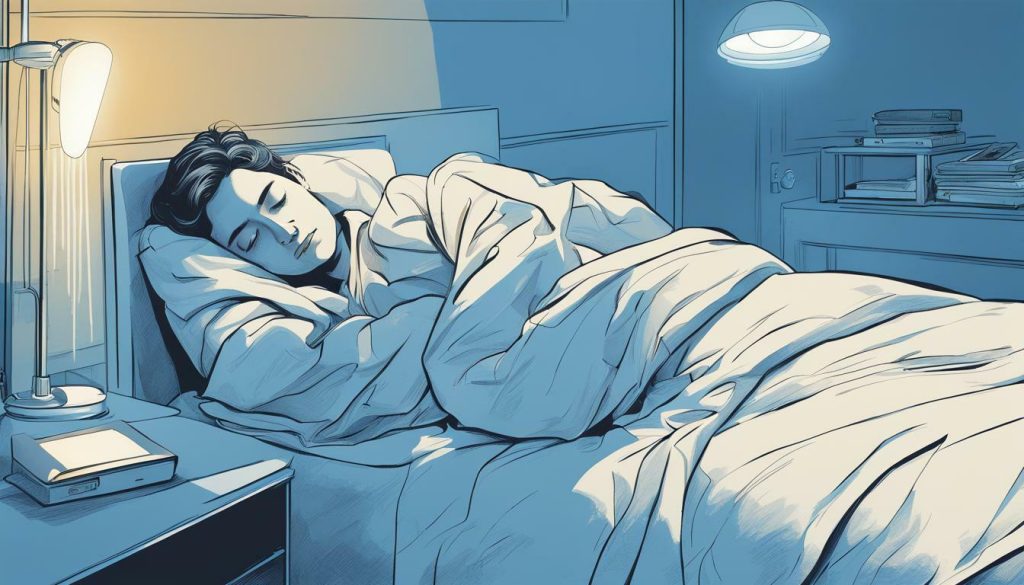
The Role of Light Exposure During the Day
Light exposure during the day plays an important role in regulating our circadian rhythm. It signals to our bodies that it is daytime and helps to keep us awake and alert. Studies have shown that exposure to natural light can improve sleep quality and duration, as well as overall health and well-being.
Outdoor activities such as walking, hiking, or gardening are great ways to incorporate natural light into your daily routine. However, for those who are unable to spend time outdoors, bright indoor lighting can also be effective. It’s important to aim for at least 30 minutes of light exposure in the morning to help regulate the sleep-wake cycle.
Additionally, avoiding bright light exposure in the evening can also help to promote healthy sleep patterns. Dimming indoor lighting and reducing electronic device use before bed can signal to our bodies that it is time to wind down and prepare for sleep.

Incorporating light exposure during the day into your daily routine can help to regulate your circadian rhythm and improve overall sleep quality. Whether through outdoor activities or bright indoor lighting, it’s important to prioritize light exposure for optimal health and well-being.
Blue Light and Shift Work Sleep Disorder
Individuals who work night shifts or have irregular sleep schedules face a unique set of challenges when it comes to managing their sleep. Shift work sleep disorder is a condition where the body’s natural circadian rhythm is disrupted, leading to insomnia or excessive sleepiness. Blue light exposure can worsen the symptoms of shift work sleep disorder, making it even more difficult to get the restorative sleep needed to function optimally.
Studies have shown that exposure to blue light during the night shift can suppress melatonin production, disrupting the natural sleep-wake cycle. This can lead to difficulty falling asleep, decreased sleep quality, and daytime sleepiness. Additionally, the use of electronic devices during breaks or after work can further exacerbate the effects of blue light exposure, making it crucial for shift workers to manage their exposure to blue light both on and off the job.
One effective strategy for managing blue light exposure during shift work is to wear blue light filtering glasses. These glasses block out blue light wavelengths and can help to regulate the circadian rhythm. Additionally, it is important to create a sleep-conducive environment by optimizing bedroom lighting, minimizing noise and distractions, and maintaining a consistent sleep schedule whenever possible.
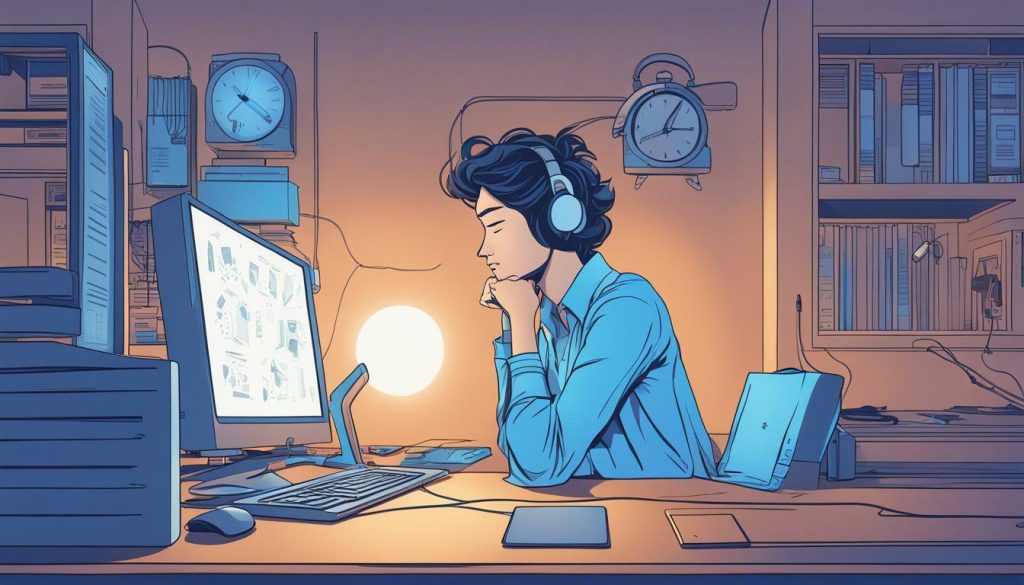
By taking proactive steps to manage blue light exposure, shift workers can mitigate the effects of circadian rhythm disruption and improve their overall sleep quality.
Blue Light and Children’s Sleep Patterns
Children are particularly susceptible to the negative effects of blue light on sleep quality and circadian rhythm disruption. Research suggests that excessive screen time can lead to delayed sleep onset, less overall sleep, and lower quality sleep.
Parents can take steps to help their children maintain healthy sleep habits. One strategy is to establish a consistent bedtime routine that includes limiting screen time before bed. Encouraging outdoor activities during the day can also help regulate the sleep-wake cycle.
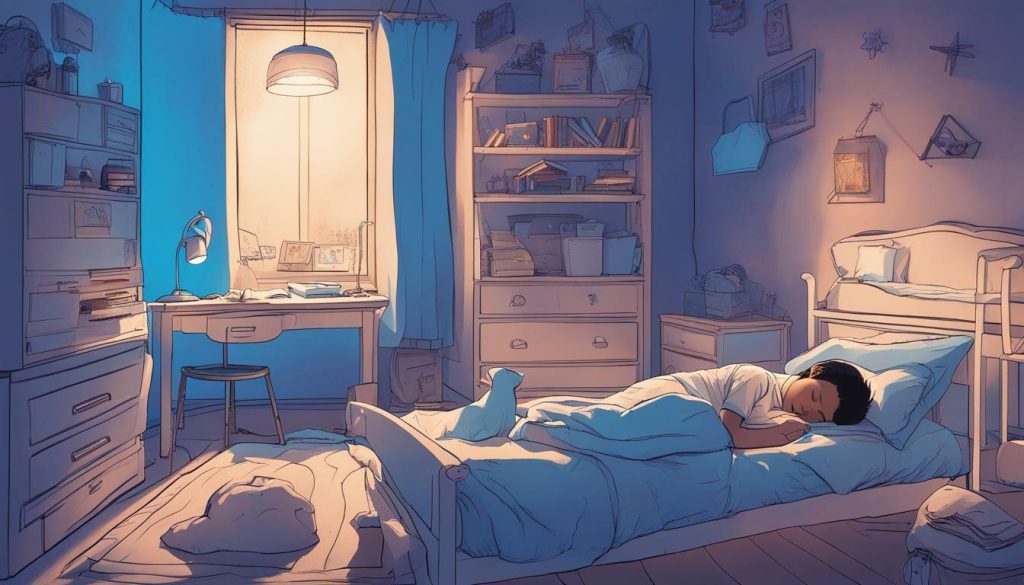
It’s important for parents to recognize the potential impact of blue light on their child’s sleep patterns and take proactive steps to manage their exposure. By promoting healthy sleep habits, parents can support their child’s physical and mental well-being.
The Future of Blue Light Management
The increasing awareness surrounding the harmful effects of blue light on the circadian rhythm has led to the development of new technologies aimed at managing exposure. Research has shown that blue light filters, such as those found on certain electronic devices and glasses, can significantly improve sleep quality by reducing exposure to blue light.
Another innovative solution being explored is the use of specialized lighting systems that mimic natural sunlight. These systems are designed to regulate the circadian rhythm by providing the appropriate levels of light at different times of the day. This technology has shown promising results in reducing circadian rhythm disruption and can aid in managing sleep disorders associated with shift work.
As the scientific community continues to investigate the effects of blue light, it is likely that more effective and accessible solutions will emerge. It is important to remain aware of the potential risks associated with blue light exposure and prioritize the management of exposure to improve sleep quality and overall health.
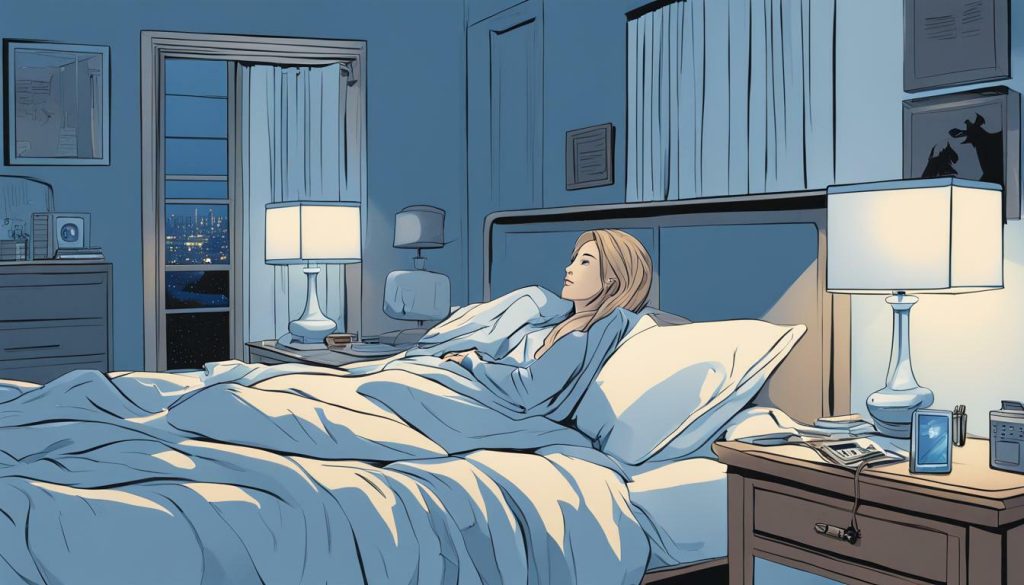
Conclusion
Managing blue light exposure is crucial for maintaining a healthy circadian rhythm and improving sleep quality. As we have seen, blue light can disrupt our natural sleep-wake cycle and suppress the production of melatonin, a hormone vital for regulating sleep.
Reducing screen time before bed, using blue light filters, and optimizing bedroom lighting are practical strategies for managing blue light exposure. It is also important to incorporate outdoor activities and exposure to natural light during the day to regulate the circadian rhythm.
Shift workers and children are especially vulnerable to the negative effects of blue light on sleep patterns, and it is vital to take proactive measures to manage their exposure.
Emerging technologies and ongoing research offer promising solutions for managing blue light exposure in the future. By being proactive in managing our exposure to blue light, we can ensure better sleep quality and overall well-being.
FAQ
Q: What is the impact of blue light on your sleep cycle?
A: Blue light can disrupt your circadian rhythm, which is responsible for regulating your sleep-wake cycle. Exposure to blue light, especially in the evening, can interfere with the production of melatonin, a hormone needed for quality sleep.
Q: What is circadian rhythm and why is it important?
A: Circadian rhythm refers to the natural, internal process that regulates your sleep-wake cycle. It is important because it helps maintain a consistent pattern of sleep and wakefulness, ensuring optimal physical and mental well-being.
Q: How does blue light disrupt the circadian rhythm?
A: Blue light exposure, particularly from electronic devices and LED lights, can suppress melatonin production, leading to circadian rhythm disruption. This can result in difficulty falling asleep, poor sleep quality, and daytime fatigue.
Q: What are common sources of blue light that affect sleep?
A: Common sources of blue light include electronic devices like smartphones and tablets, LED lights, and natural sunlight. Exposure to these sources, especially in the evening, can negatively impact sleep quality and duration.
Q: How does blue light affect melatonin production?
A: Blue light exposure inhibits the production of melatonin, a hormone that helps regulate the sleep-wake cycle. This can result in difficulty falling asleep and disruptions to the natural sleep rhythm.
Q: How can I manage blue light exposure for better sleep?
A: To manage blue light exposure, it is recommended to reduce screen time before bed, use blue light filters or glasses, and optimize bedroom lighting to create a sleep-friendly environment.
Q: What is the role of light exposure during the day?
A: Light exposure during the day helps regulate the circadian rhythm. Spending time outdoors, especially in natural light, can help maintain a healthy sleep-wake cycle and improve overall sleep quality.
Q: How does blue light affect shift workers?
A: Blue light exposure can exacerbate sleep disorders associated with shift work. It can make it even more challenging for individuals with irregular sleep schedules to maintain a healthy circadian rhythm and get quality sleep.
Q: How does blue light impact children’s sleep patterns?
A: Excessive screen time and exposure to blue light can disrupt children’s sleep patterns. It is important for parents to limit screen time before bed and establish consistent sleep routines to help children develop healthy sleep habits.
Q: What does the future hold for blue light management?
A: Ongoing research and emerging technologies aim to develop innovative solutions for managing blue light exposure. These advancements hold promise for improving sleep and overall well-being in the future.

